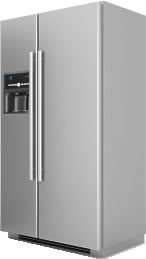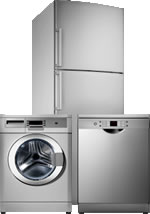Design Considerations for a Kitchen Refrigerator

|
The refrigerator tends to be the anchor of any kitchen. It gets heavy use and people tend to have a strong preferences in what makes just the right one. If you haven't already discovered, the number of possible choices is huge. This vast selection reflects the unique needs and desires people have for their own personal refrigerator. Laying out the kitchen and choosing the right refrigerator for that layout is an important design consideration for creating a kitchen that works well for you.
Work Triangle
Every kitchen should have a work triangle, that is, a straight line relationship between the three most used work areas in the kitchen. The stove, the sink or prep area and the refrigerator are the three locations you will spend the most time walking between. To improve comfort and convenience, you should minimize the number of steps you must take between those stations and ideally those pathways should be straight lines. If you had to go into another room every time you needed something from the fridge that would be a big inconvenience. Well, something as simple as having to walk around to the far side of an island can become just as big of an annoyance when repeated over and over.
Plan your kitchen such that you can draw an uninterrupted triangle between your prep area, stove and refrigerator. Also, keeping those pathways as short as possible is preferable, although not to the point that they are crowded together. It is important to leave room for people to work together in a kitchen if at all possible.
Positioning the Refrigerator
The location of the refrigerator may be dictated by the configuration of your room and the location of other features such as the stove and sink. However, if you have some flexibility, consider these points. Because the doors can be wide on many refrigerators, make certain that there is room for the door to open without obstruction from an island or other element. Choose a location where the open door of the refrigerator will not block traffic. Many refrigerators require the door to be open all the way for a drawer to be fully accessible. This is an important consideration if the refrigerator will be near a wall, an inside corner of countertop or interfere with someone at a nearby work station. Finally, access to the refrigerator often results in the need to set things down as they are placed into it or removed. Having some convenient counter space adjacent to the refrigerator is very helpful. If the space is to the left or right of the fridge, consider this when choosing a left-hand or right-hand swinging door.
How Big of Refrigerator do I Need?
Everyone's lifestyle is different and their refrigeration needs vary accordingly. The size of refrigerator you need is primarily affected by your family size. Other considerations are whether you do a lot of entertaining or tend to prepare more complex meals. Refrigerators measure total capacity in cubic feet, and though the usability of that space varies between manufacturer and model, it is fundamental factor for comparison. Our rule of thumb is 14 cubic feet plus 2 cubic feet for each family member. So, a family of four would typically need a refrigerator with a capacity of about 22 cubic feet.
Refrigerators usually split the space with the freezer at around a 30 / 70 ratio. So, a 20 cubic foot unit would use about 30% of the space or 6 cubic feet for the freezer and the remaining 70% or 14 cubic feet for the refrigerator. Large families typically require more freezer space while families that do a lot of entertaining require more refrigerator space. When choosing a model, note the ratio of freezer to refrigerator space to make certain it will meet your needs.
If your kitchen space is limited and you don't have enough room for the size refrigerator you need, consider buying two refrigerators and putting the second in another location. A second refrigerator can be placed in a walk-in pantry, an underused closet or even the garage if there is no other space. Also, the second fridge doesn't have to be full sized. Consider using a mini-fridge, possibly as storage for drinks, or a fridge for the kids to keep their drinks and snacks.
Style and Look
There are a wide variety of styles and configurations, see our Refrigerator Guide for more information, and your decision will be influenced by your preferences and budget. However, there are some considerations that are relevant to nearly all styles and price ranges. If you want your refrigerator to blend in or match your cabinets, look for models that accept cabinet panels or offer trim kits. This feature allows you to install wood, or nearly any material as the appearance facade of your refrigerator.
Another consideration for keeping your refrigerator looking nice is its finish. Although very popular, stainless steel shows fingerprints and must be cleaned regularly to keep it looking good. There are several simulated stainless options that look good and don't show fingerprints as easily. A textured finished doesn't show fingerprints and is easy to keep clean. However, this finish is usually only found on free-standing units. Cabinet panels are usually coated with the same finish as your cabinets; they are easy to clean and usually don't show prints.





